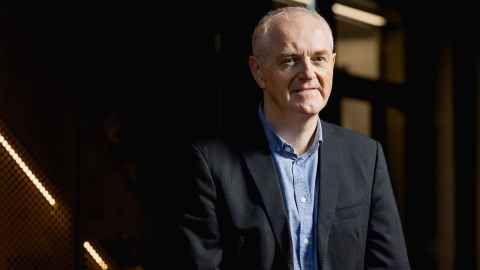NZ leads world in trial of futuristic therapy
26 August 2022
An innovative treatment that repairs a faulty genetic mechanism is being trialled by Kiwis with a rare muscle disease for the first time in the world.

It sounds like science fiction when a neurologist describes it, but a treatment that works at the gene level to solve the root cause of a genetic disease will soon be tested at the University of Auckland for the first time in the world.
The molecular therapy will be used to treat ten people with myotonic dystrophy, a progressive muscle disease that is passed on from generation to generation. It affects around half of family members and gets worse over time and over generations.
“Myotonic dystrophy is a muscle disease, but it also affects the brain and heart; it causes diabetes. We come across it in all sorts of specialties,” neurologist Associate Professor Richard Roxburgh says.
Myotonic dystrophy affects more than 300 people in Aotearoa New Zealand. It can cause sudden unexpected death in some people, while others live with the disease for many years.
Scientists found the genes causing many genetic diseases in the 1990s, but only in recent years have therapies been reaching the stage of clinical trials and/or availability for prescription.
US company Dyne Therapeutics is running the ‘first in human’ trial at the University of Auckland, with other sites around the world joining once they also get regulatory approval. Roxburgh is hopeful about the treatment, which has shown a good safety profile in overseas animal studies.
“And the great thing about genetics is that when it comes to a clinical trial, I can say for sure that the people taking part in the trial definitely have this muscle disease not another muscle disease so if it works in the trial it will work for other people with the condition.”
Clinicians hope that the trial medication will halt or even reverse the disease’s impacts, because it acts at such a fundamental level of the disease process.
When Roxburgh describes the way the treatment works, it sounds like intracellular Star Wars and most of us would struggle to understand it.
Myotonic dystrophy is caused by an expansion in a person’s DNA where a section of DNA repeats hundreds or thousands of times. The more repetitions, the worse the symptoms.
“The elongated piece of DNA leads to an elongated piece of messenger RNA (mRNA),” Roxburgh says.
mRNA is a copy of DNA that travels out into the cell and instructs the cell’s machinery to make the proteins that carry out the body’s activities.
“The expanded mRNA is toxic to cells. This is because it is so big that it sucks in all the things that the cell uses to process mRNA and then they are not available to process other mRNA to do their work. So proteins all over the body don’t get processed properly and you get those multiple symptoms,” Roxburgh says.
“Dyne has devised a pretty clever system,” Roxburgh says. “You have an antibody with a piece of artificial DNA attached to it. The antibody targets a particular protein on muscle cells. When it binds to that protein, the protein takes it into the cell. Then the piece of artificial DNA breaks off and enters the nucleus. It looks around and, because that DNA with expansions matches a sequence near the expanded RNA, they get together like zippers. Your body looks at that and says ‘DNA linked to RNA? That RNA is a virus. And it sets in motion its own protective system to get rid of the ‘virus’ and it destroys the RNA.
“We are hoping that, if we can destroy this problem RNA, which is sucking in everything, all the proteins that are used for controlling and doing the right thing for the rest of the RNA will be freed up to do their usual job.”
Programme manager Miriam Rodrigues has been working with people with myotonic dystrophy for many years and says the trial is exciting because there’s currently treatment that affects the course of the disease; rather symptoms are treated.
“Our hope is the treatment will restore people to someone who doesn’t have that genetic mistake that myotonic dystrophy brings.”
Patients will start receiving the medicine as an infusion from September, as part of a randomised controlled trial that will run for six months, with another 18 months of follow-up monitoring.
“These participants will be receiving the medication through a collaboration with New Zealand Clinical Research who are incredibly experienced at running trials like this,” Roxburgh says.
Roxburgh emphasises the unknown aspect to the trial. “While the hope is that it will make a positive difference. It has never been tried in human subjects before, so the principal question for the trial is: is it safe? I am full of admiration for people who are prepared to take this risk but then the risk of doing nothing when you have this condition needs to be considered too.”
Aotearoa New Zealand was chosen to lead the study, for three reasons. Firstly, the University of Auckland is one of 16 centres internationally that are part of the myotonic Dystrophy Clinical Research Group and have access to the equipment needed to monitor the outcomes; secondly because of Pūnaha Io – the New Zealand NeuroGenetic Registry and Biobank which allows potential participants to be identified; and thirdly because MedSafe and the Health & Disability Ethics Committee gave approval swiftly.
Media queries
FMHS media adviser Jodi Yeats
M: 027 202 6372
E: jodi.yeats@auckland.ac.nz